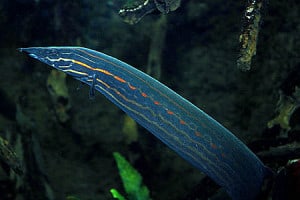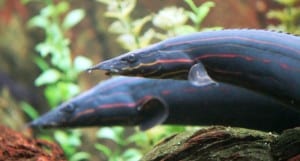
Common name: Fire Eel
Scientific name: Mastacembelus Erythrotaenia
Average Adult Fish Size: 40 inches / 100 cm
Place of Origin: India, Borneo, Malaysia, Sumatra, Sri Lanka, Thailand and Burma. Soft Southeast Asian riverbeds.
Typical Tank setup: The bottom of your aquarium should have a fine substrate without any sharp edges, since sharp edges can cut into the eel as they like to dig into the sand. Also try to have hiding place like rock caves or bog wood. The fire eel also like plants to swim through.
Recommended Minimum Aquarium Capacity: 64 gallon / 240 litre
Compatibility: The Fire eel is actually quite peaceful, especially when it comes to young eel’s. Keeping it with small fish like Tetra’s and Guppies is however a bad idea since these will be considered prey. You can keep your Fire eel in a community aquarium with medium sized or large cichlids like Jack Dempsey’s or Green Terrors.
Temperature: 75 – 81 Deg. F / 24 – 27 Deg. C
Water chemistry: pH 6.0 – 7.5
Feeding: Use live food, such as feeder fish, mosquito larvae, cyclops, bloodworms and brine shrimp. Many Fire eels will accept flakes and catfish sinkers in captivity, but live food should always be included in their diet.
Sexing: To differentiate the sexes can be difficult, but a mature female is big and more well rounded than the male. When spawnings have occurred in captivity, the parents have been longer than 50 centimetres (20 inches).
Breeding: The Fire eel is a plant spawning fish that should be kept in a large and well planted aquarium. Keep the pH and dH at optimal levels and let the water temperature become a little higher than normally, from 27 to 29° C (81 to 84° F). The eggs are translucent and the female Fire eel will place roughly 800 to 1200 eggs in floating plants. The eggs are around 12 millimeters (1/20 inch) in diameter. Newly hatched Fire eels must be feed very small live food. Over feeding the fry is a common reason behind extensive Fire ell fry death. When kept on a suitable diet, the fry will grow very fast.
Additional Information: It is important that you cover the aquarium, as the Fire eel can jump quite high. It is also a skilled escape artist and the aquarium must be properly sealed.
The unusually long body of the Fire eel has a dark brown colour, apart for the belly which is light brown to light grey. The body is usually decorated with bright red lateral stripes and spots, and these patterns can be used to differentiate one individual from another. The dorsal, pectoral and anal fin will also very often display a red edging. The decorative patterns will change as the fish ages, and young fish will typically display yellow decorations that gradually become more red as the fish reaches adulthood. The intensity of the colour will often be affected by the general condition of the fish. A few of the most common health problems among Fire eels are parasite attacks, injuries and shock.



Related Posts
Croaking Gourami – Trichopsis vittatus
Benthochromis Tricoti
Large-eyed Mouthbrooder – Callochromis Macrops